trees, shrubs, and climbers
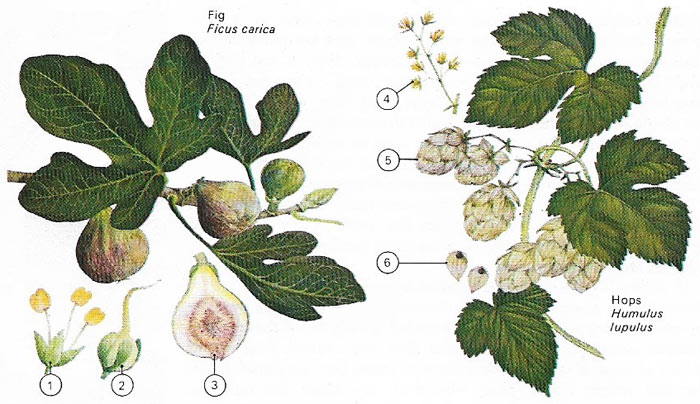
Figure 1. The plant order Urticales contains a number of diverse families as widely different as the elms, figs, hops, and stinging nettles. Most of these are grown commercially. The fig is grown for its fruit in the warmer areas of Europe. Male flowers (1) and female flowers (20 are found on the same tree. The fruit (3) is shown in section. Hops are widely cultivated in southern England and are used to flavor beer. Shown here are the male flower (4), the fruit (5) on a branch and the seeds (6). The other member of the Urticales that is commercially important is the elm, which is grown for its versatile timber.

Figure 2. The elder (family Caprifoliaceae), native to Europe, grows to a height of 12 meters (40 feet). In early summer the tree bears clusters of white flowers.
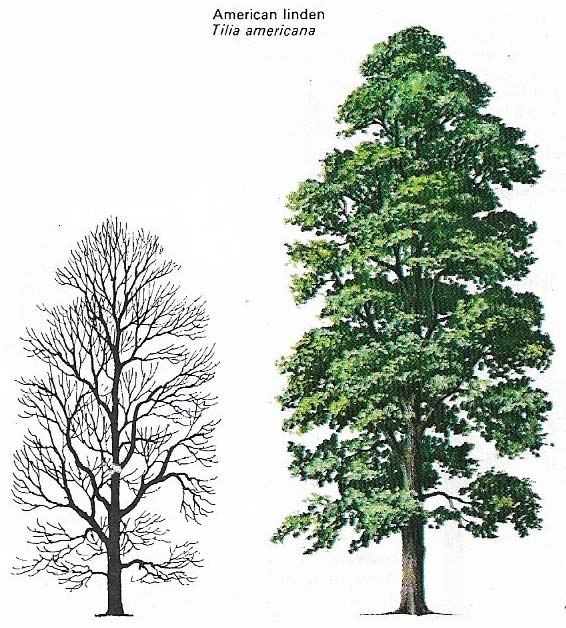
Figure 3. The limes or lindens (family Tiliaceae) have some of the largest leaves found on deciduous trees. Of these the largest – 30 centimeters (12 inches) long – are on the American basswood of North America.
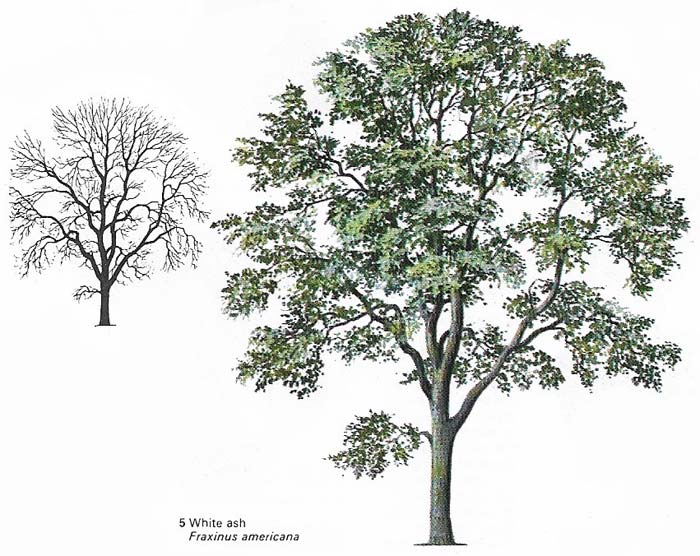
Figure 4. The leaves of the ash (family Oleaceae) are distinctive in being split into many small leaflets giving the impression of fine foliage. The white ash of eastern North America is a timber tree up to 41 meters (135 feet) in height.
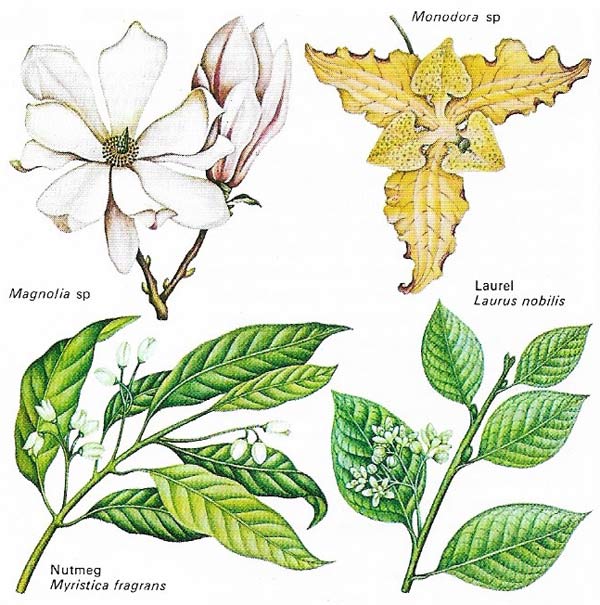
Figure 5. The plant order Magnoliales includes the magnolia and the nutmeg and consists entirely of woody plants. They are not native to Europe but have been introduced for ornamental purposes. The magnolia is indigenous to Asia and North America and is a popular garden plant because of its early pink and white blooms. Monodora is a West African jungle tree yielding spices and drugs. It is cultivated in the West Indies. Myristica is the nutmeg tree and is native to the East Indies. Laurus, the laurel, is native to the Mediterranean countries and its fruits and the leaves are gathered for spices and medicines.

Figure 6. The beech of the Northern Hemisphere (family Fagaceae) does well on chalky soil. Male flowers grow in clusters and are separate from the female ones. The Antarctic beech is 30 meters (100 feet) tall and grows in the Andes and in southeastern Australia and New Zealand. It differs from its northern cousin in being an evergreen species. Although the eastern beech belongs to the same genus as the Antarctic, like the northern beech it attains a height of up to 36 meters (120 feet).

Figure 7. The walnut (family Jaglandaceae) is a decorative tree prized for its fruits and its fine timber. The nuts are pressed to give an edible oil. It grows to 50 meters (160 feet) and is one of the last trees to gain its leaves in the spring and first to lose them later. Most of the 15 species of walnut are found in the Northern Hemisphere but the genus extends into the Andes. The black walnut is North American.

Figure 8. The hawthorn (family Rosaceae) is an ideal tree for hedge planting because of its hardiness and its display of thorns. It grows to 11.5 meters (35 feet) and its heavily scented blossom is conspicuous in late spring and early summer in the hedgerows of Europe.

Figure 9. The sycamore (family Aceraceae) is the largest of the maples and can grow to a height of 33 meters (110 feet). It is also the fastest growing, reaching its full height in 60 years. Its leaves,however, are prone to fungal attack.
Most of the world's flowering trees are noted more for their shape and form than for their flowers. Nearly all of the broad-leaved species (as distinct from narrow-leaved conifers) are deciduous and are members of the group of plants known as dicotyledons.
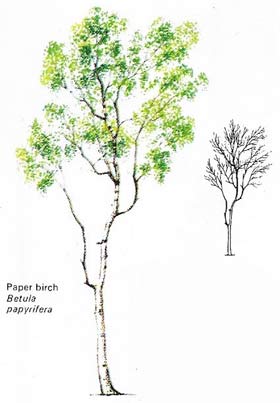 |
| Birches (family Betulaceae) are characterized by their feeling bark and are adapted to poor soil and extreme cold. The paper birch grows to 39 meters (130 feet) and is found in North America. |
During the evolution of the flowering trees, shrubs, and climbers the great step forward came with insect pollination rather than wind pollination. One advantage of this is that there is no need for trees to grow in large stands in order for pollination, and thus fruit formation, to be successful.
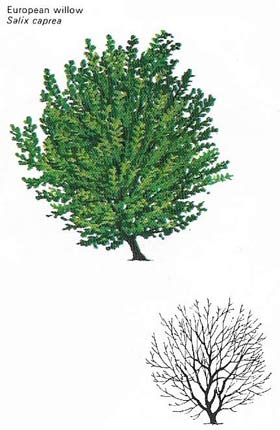 |
| The willows (family Salicaceae) are fairly small trees, the European willow growing to 10 m (35 ft). The seeds are light, wind dispersed, and contain little food. They often grow by water where rapid germination is effected. |
Most trees with significant, attractive flowers belong to one of three plant families, the Magnoliaceae (magnolias), the Rosaceae (roses), and the Leguminosae )peas). Of these the rose relatives are the most important economically because they often bear edible fruits – apples, pears, plums, and cherries – for which they are cultivated. The fruits of many tree families are eaten by man and include the olives (Oleaceae), figs (Moraceae), walnuts and pecans (Juglandaceae), chestnuts (Fagaceae), and oranges, limes, and lemons (Rutaceae).
 |
| The holly (family Aquifoliaceae), with its thick foliage of evergreen thorned leaves, is planted as a windbreak and for ornamental purposes. Its red, winter berries create a striking contrast to the dark foliage. It grows to 21 meters (70 feet). |
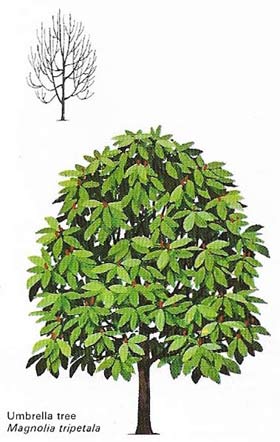 |
| The umbrella tree (family Magnoliaceae) is popular in gardens. There are 80species of Magnolia: the one shown here,from North America, grows to a height of 13 meters (45 feet). |


